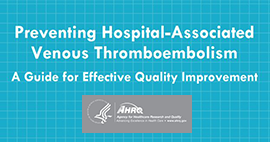Hospital-associated venous thromboembolism (HA-VTE) is a common source of morbidity and mortality. While VTE sometimes occurs despite the best available prophylaxis, there are many lost opportunities to optimize prophylaxis and reduce VTE risk factors in virtually every hospital. This guide targets these failure modes in the process of preventing VTE in the inpatient setting and provides improvement teams with field-tested strategies and tools to enhance their chances of success. Several essential elements are needed to achieve meaningful improvement in VTE prevention. These include an empowered, interdisciplinary team, supported by the institution, to standardize processes, monitor and measure VTE processes and outcomes, implement institutional policies, and educate providers and patients. Guidelines for VTE prevention are numerous and do not always agree, and the complexity of the inpatient setting and the variability of patients make implementation of evidence-based guidelines challenging. This implementation guide reviews several guidelines, with a particular focus on the implications for implementation; it then breaks down the steps to translate these guidelines into practice in the form of a VTE prevention protocol. Read more…
AHRQ’s Preventing Hospital Associated VTE Guide

